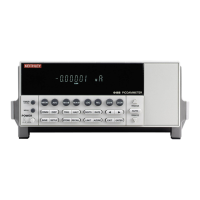10-10 Status Structure Model 6485 Picoammeter Instruction Manual
Programming example — set MSS (B6) when error occurs
The first command of the following sequence enables EAV (error available). When an
invalid command is sent (line 4), bits B2 (EAV) and B6 (MSS) of the status byte register
set to 1. The last command reads the status byte register using the binary format (which
directly indicates which bits are set). The command to select format (FORMat:SREGister)
is documented in Table 10-2. To determine the exact nature of the error, you will have to
read the error queue (see “Queues,” page 10-18).
*CLS ' Clear Error Queue.
*SRE 4 ' Enable EAV.
FORM:SREG BIN ' Select binary format.
BadCommand ' Generate error.
*STB? ' Read Status Byte Register.
NOTE An example program to demonstrate serial polling (Generating SRQ on buffer
full) is provided in Appendix E.
Status register sets
As shown in Figure 10-1, there are four status register sets in the status structure of Model
6485; standard event status, operation event status, measurement event status, and ques-
tionable event status.
Register bit descriptions
Standard event status
The used bits of the standard event register (Figure 10-4) are described as follows:
Table 10-3
Common commands — status byte and service request enable registers
Command Description Default
*STB? Read status byte register.
*SRE <NDN> or <NRf> Program the service request enable register:
<NDN> = #Bxx…x Binary format (each x = 1 or 0)
= #Hx Hexadecimal format (x = 0 to FF)
= #Qx Octal format (x = 0 to 377)
<NRf> = 0 to 255 Decimal format
(Note)
*SRE? Read the service request enable register
Note: *CLS and STATus:PRESet have no effect on the service request enable register.

